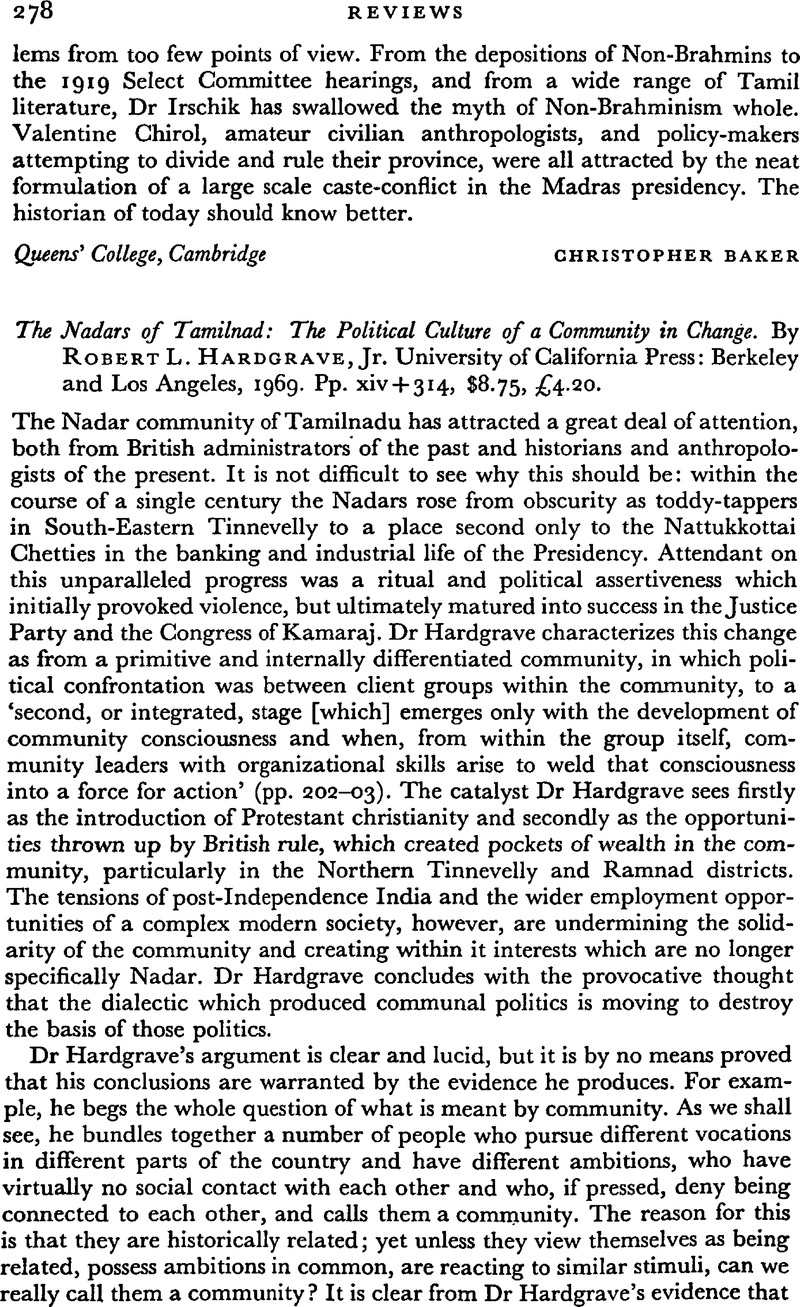Article contents
The Nadars of Tamilnad: The Political Culture of a Community in Change. By Robert L. HardgraveJr., University of California Press: Berkeley and Los Angeles, 1969. Pp. xiv + 314, $8.75, £4.20.
Published online by Cambridge University Press: 28 November 2008
Abstract

- Type
- Reviews
- Information
- Copyright
- Copyright © Cambridge University Press 1971
References
1 Dr Hardgrave notes that the barriers are beginning to break down only today. Hardgrave, The Nadars of Tamilnad, p. 170.Google Scholar
2 For an analysis of this process see Stein, Burton, ‘Social Mobility and Medieval South Indian Hindu Sects’, in Silverberg, J. (ed.), Social Mobility in the Caste System in India: An Interdisciplinary Symposium (The Hague, 1968), PP. 78–94.Google Scholar
3 G.O. 87. (Local and Municipal, Legislative), dated 31 October 1917. T[amil] N[adu] A[rchives].Google Scholar
4 ‘The Nadars then turned from the emulation of “twice-born” cultural models to the pursuit of secular, economic and political goals in the creation of the Nadar Mahajana Sangham, the caste association which became the agent of community integration and mobilization.’ Hardgrave, , op. cit., p. 262.Google Scholar
5 Report of the Third Indian National Congress held at Madras on 27th, 28th, 29th and 30th December 1887 (London, 1887), p. 173.Google Scholar
6 See G.O. 1203 (Municipal) dated 1 July 1912. TNA; Hindu 1 July 1918.Google Scholar
7 G.O. 1016 (Municipal) dated 13 September 1888 TNA.Google Scholar
8 Thus, for example, the Nadar Mahajana Sangam went looking for support from Tiyyas and Gramanis, who form no part of the Nadar ritual community. Hardgrave, , op. cit., p. 178. Also the Sangam, formed from a community which sought higher status, campaigned to be included in the list of depressed classes.Google Scholar Hardgrave, , op. cit., p. 141.Google Scholar
9 Hindu, 10 June 1896.Google Scholar
10 ‘As the voice of the community, in articulating its interests and formulating its demands, the caste association was the vehicle by which the Nadars entered the political system.’ Hardgrave, , op. cit., p. 262.Google Scholar
11 The initial meeting for the foundation of the Sangam was held at Ratnaswami's bungalow at Porayar in February 1910. Hindu, 7 February 1910.Google Scholar
12 For example: V. Remabhadra Naidu, the zemindar of Doddapanayakannur, was a member of the local Legislative Council, chairman of a municipality and patron of the Telugu Academy before he founded the Naidu Sangam. Salla Guruswami Chetty of the Arya Vysya Mahasabha had spent many years on the Madras Corporation. The Thondamandala Vellala Sabha included at its foundation K. Chidambaranatha Mudaliar of the Legislative Council, T. V. Gopalaswami Mudaliar, a Mylapore lawyer and leading Madras City Congressmen and the zamindar of Uttapalliam, a power in the Madura District.Google Scholar
13 ‘Addresses presented in India to His Excellency The Viceroy and The Right Honourable The Secretary of State for India’, Appendix I, p. 88.Google Scholar Parliamentary Papers 1918, Vol. XVIII, pp. 469–587.Google Scholar
14 Hindu, 7 July 1910.Google Scholar
15 Fox, R.. ‘The Avatars of Indian Research’, Comparative Studies in Society and History, Volume 12, Number 1, 01 1970, pp. 59–72.CrossRefGoogle Scholar
16 Memorial of Gurunatha Nadar in Statement of Memorials withheld by the Government of India and Provincial Governments. Public and Judicial Department Proceedings, File 452 of 1885, India Office Library.Google Scholar
17 Letter of Tathachariar, S. D., Hindu, 6 July 1920.Google Scholar
- 2
- Cited by


